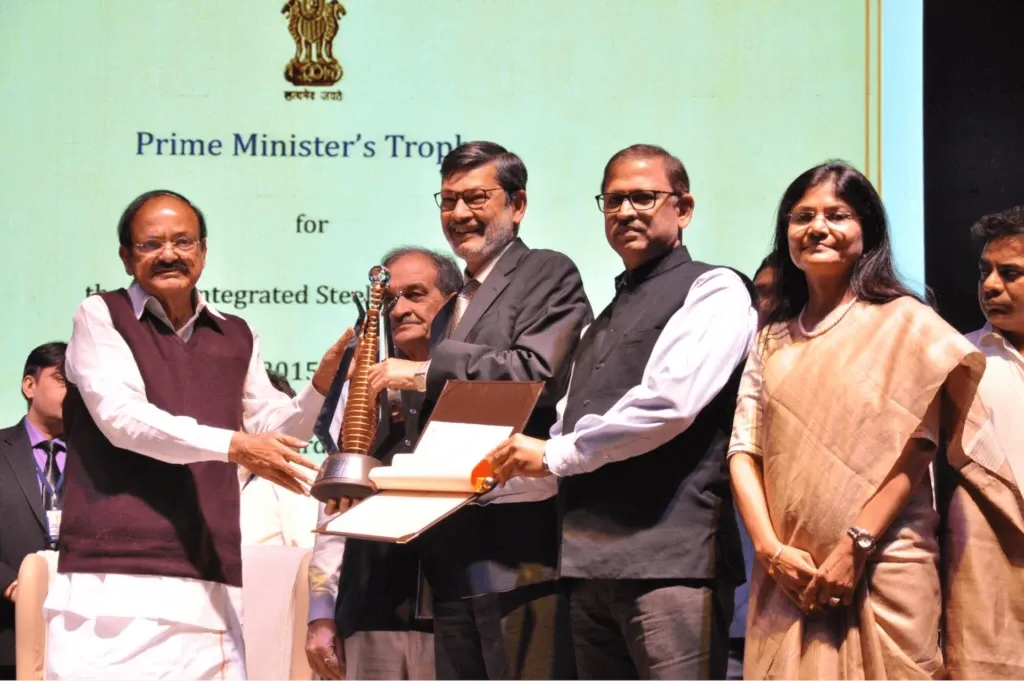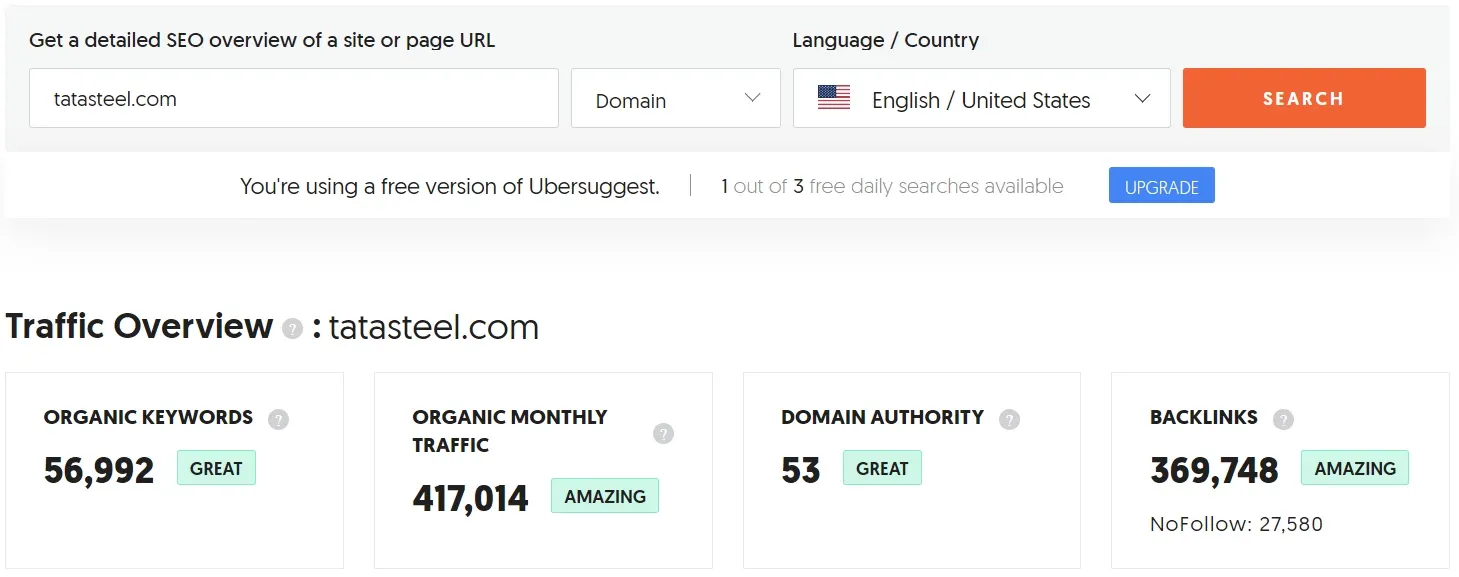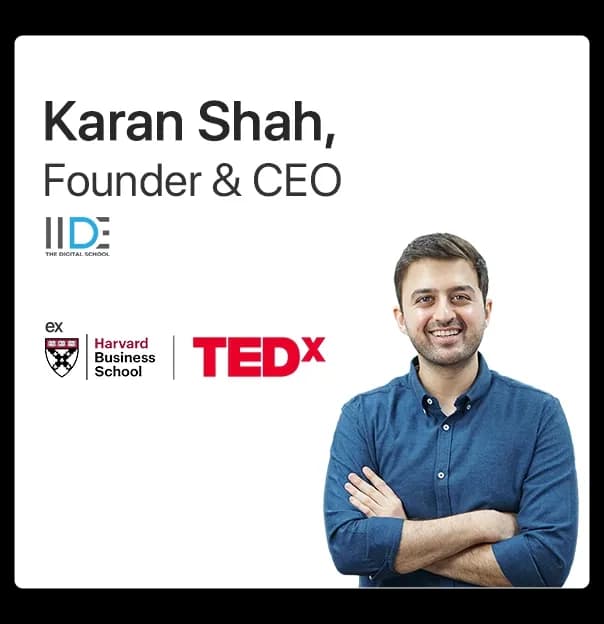🚀 Just Launched — Our New Undergraduate Program in Digital Business & Entrepreneurship is Here: Explore Now!
Resources
Career & Placements
Digital Business Program
- Bachelors/UG in Digital Business & Entrepreneurship
Newly Launched
Digital Marketing Courses
Free Masterclass
Previously, we had discussed the marketing strategy of Godrej Properties. Today, in this blog we will be elaborating the marketing strategy of Tata Steel.
Tata Steel is India’s Leading Steel Manufacturing Company, and its presence is recognized all over the world. It is also quite popular for its unique and appealing Marketing Strategies. They aim to examine their external surroundings and market their products according to the Latest Trends, risks, and opportunities. It now has a ranking amongst the top 10 current steel producers.
The goal of this marketing strategy of Tata Steel is to understand the company from a marketing perspective by examining its 4 Ps marketing mix, marketing, and advertising strategy, its digital presence, and an overview of its competitors in the coming areas. Also, do read our other blog which describes Tata Group’s marketing strategies.
A company’s marketing strategy can make or break its success. Marketing has adapted as individuals from all around the world search for the digital world. However, if you’re interested in learning digital marketing, check out our free masterclass on the subject, Digital Marketing 101.
Let us begin by knowing Tata Steel as a firm.
Aditya Shastri
Lead Trainer & Business Development Head at IIDE
Updated on: Oct 14, 2024
About Tata Steel

Initially known as Tata Iron and Steel Company Ltd, Tata Steel is one of the leading companies in the world that Manufactures Steel and Iron. Jamshetji Tata created the company in 1907. Tata Steel started from Jamshedpur, Jharkhand,d and is also a subsidiary of Tata Group. Its headquarters is currently in Mumbai, Maharashtra.
Tata Steel currently works with 26 countries with its major projects focused on India, UK, and The Netherlands. It also employs approximately 81,000 people. Over the years, Tata Steel has tremendously grown and has been fruitful in the last five years. From mere beginners in the Industry, they evolved and became a major game-changer in the Steel Manufacturing Industry. They have vigorously participated in takeovers for further expansion and growth. Tata Steel is India’s second-largest steel producer, with 25.3 million tonnes of finished steel and 9.7 million tonnes of crude steel in 2015.
What’s new about Tata Steel
Check out some current news about Tata Steel:
- Tata Steel plans to scale up the usage of hydrogen in the steel-making process
- ACME Group signs agreement with Tata Steel subsidiary for green hydrogen project in Odisha
- Tata Steel Foundation’s Urban Services blood donation camp collects 300 units
Target Audience
Tata Steel, a multinational steel manufacturing company, has a diverse range of products and services that cater to various industries and markets. The target audience of Tata Steel can vary based on its different product lines and business segments. Here are some of the key target audiences for Tata Steel:
- Industrial and Manufacturing Sectors
- Construction Companies
- Automotive Industry
- Infrastructure Development
- OEMs (Original Equipment Manufacturers)
Check out the following mentioned buyer’s persona of Tata Steel to better understand the target customer:
Tata Steel’s Marketing Mix
Marketing Mix refers to the techniques or tactics used by a company to promote its products or services in the Market. These are also known as the 4P’s and include – Product, Price, Promotion, and Place.
1. Tata Steel’s Product Strategy

Tata Steel’s products mainly include those products that are manufactured in India and also involve Thailand and Singapore operations. It also includes the products manufactured by Corus in the United Kingdom and The Netherlands. All these products form part of the Product Strategy.
The Products of Tata Steel include finished and semi-finished goods and long products like wire rods and bars. They specialize in a variety of ores like Chrome, Manganese, and Ferro Manganese and further branched out into products like Locomotive Parts, Precision tubes, and bearings. Whereas, Corus i.e. an acquisition of Tata Steel deals in coated strip products in coil and sheet form. This shows the wide variety of products that Tata Steel has to offer.
2. Tata Steel’s Pricing Strategy
The pricing of any product is of utmost importance as it determines its demand, the favourability of the product, and many more aspects. The companies also take into consideration the purchasing power, production, material, and competition, and the most important factor is the scope of profit.
Tata Steel has always attempted to keep its prices on the lower side which has benefitted them.
- Recently, There has been an increase in the demand for Steel which has provided ample opportunities to the firm.
- Tata Steel has access to the latest technologies which enable them to maintain their productions on the lower side and maintain its standards as well.
- The Company also acquires its raw materials from the local regions but also Global Sources. They own multiple ore mines across the country.
- Due to these factors, Tata Steel can keep its prices low and also retain its customers.
3. Tata Steel’s Place Strategy
Tata Steel is a multinational corporation with operations in fifty countries throughout the world. Its corporate offices are located in Mumbai, Maharashtra, and its marketing headquarters are located in Kolkata, West Bengal. India, the United Arab Emirates, France, Malaysia, Vietnam, the United Kingdom, Canada, Thailand, Singapore, the Netherlands, China, and Australia are among the twenty-six nations where Tata Steel has manufacturing plants.
Jamshedpur, Jharkhand, is the company’s largest production factory, with a few others in Orissa, Maharashtra, Madhya Pradesh’s Indore and Pithampur, and West Bengal’s Kharagpur. The company has a New York subsidiary and operates product service centers in Norway, Finland, and Sweden. Tata Steel has a powerful and wide-ranging distribution grid that employs around 80,500 people, service centers, sales offices, direct supply channels, warehouses, consignment companies, and third-party processing agencies.
4. Tata Steel’s Promotion Strategy

Tata Steel plays a major part in B2B (also known as Business to Business) transactions. It has no means of interacting with consumers.
Tata Steel has been branding its products in such a manner that the customers get to know about them efficiently. It has launched certain advertisements where it plans to appease its customers.
For example, #Apnokeliyeaagobadho targeted the sentiments of its customers and tried to show their gratitude towards COVID-19 warriors. Another good example was their advertisement by using taglines such as “Customer First-Har Haal Mein”. The basic tools of promotion for Tata Steel were Posters and Outdoor Advertising. Messages were conveyed to satisfied consumers through the means of TV Commercials.
Marketing Strategy of Tata Steel

Tata Steel is one of the few companies that claim to provide full-fledged services from raw material acquisition to delivery of the final goods. Their current strategy would be to develop optimized models for preventing transition losses, increase the net production of their sinter plant employs approximately, and finally reduction of logistic costs and idle freight.
Tata Steel intends to strengthen its leading position and has established a set of Strategic Objectives to do so (SOs). They’ve also established a set of essential competencies known as ‘Strategic Enablers’ to help them attain the SOs.
Check out the marketing strategy of Tata Steel mentioned below:
Digital Marketing Strategy of Tata Steel
SEO Strategy

As per SEO ranking, it is said that the number of keywords – below 500 is bad, above 1000 is good, and 10,000+ is amazing. As we can see, https://www.tatasteel.com/ has a total of 56,992 organic keywords, which is regarded as excellent. Hence we can say that the digital marketing strategy of Tata Steel is remarkable.
With a monthly traffic of around 417,014, Tata Steel is undoubtedly amazing.
E-Commerce Strategy
Tata Steel owns a website where they share details regarding their products and services. Along with this they also put up blogs on various related topics and information about their press releases, Awards, etc.
Tata Steel also has an E-commerce platform Aashiyana that makes sure that buyers can purchase steel bars online just as easily as they can phones.
As a result, Aashiyana has already outperformed its pre-COVID-19 record. Orders are now coming from NRIs in Southeast Asia, the Middle East, and the US in addition to clients in India.
In Aashiyana 2.0, the portal now enables users to purchase goods from the stables of other Tata Group firms. These users are often those who are building residences.
In Aashiyana, homes are built. You now require an air conditioner, a DTH connection, insurance, and other household necessities as you construct a home. They are working with other Tata companies to produce these household goods as part of Aashiyana 2.0.
Social Media Strategy
Social media presence is a very crucial marketing strategy of Tata Steel. Tata Steel maintained an active presence on several social media platforms. Here’s the general picture of their social media presence:
- LinkedIn: Tata Steel has a strong presence on LinkedIn, where they share updates about their products, innovations, industry insights, and corporate news. They engage with professionals, showcase their projects, and connect with stakeholders.
- Twitter: Tata Steel has an official Twitter account where they share real-time updates, news, and announcements related to their business activities, sustainability initiatives, and industry trends. They also interacted with customers and responded to inquiries.
- Facebook: Tata Steel’s Facebook page is used to communicate with a broader audience, including consumers interested in their retail products like roofing solutions and home construction materials. They shared posts about their various offerings and engaged with their followers.
- Instagram: Tata Steel uses Instagram to showcase visual content related to its products, projects, and corporate culture. This platform is likely used to highlight the aesthetic aspects of their work and engage with a younger audience.
- YouTube: Tata Steel’s YouTube channel hosts videos showcasing their manufacturing processes, product demonstrations, corporate videos, and customer testimonials. This platform is used to provide in-depth content to a visually oriented-audience.
Tata Steel’s Advertising Campaigns
Multiple Ad Campaigns have been hosted as a part of the marketing strategy of Tata Steel. Take a look at the examples of initiatives started by Tata Steel.
“We Also Make Tomorrow”

Tata Steel’s most recent marketing initiative, “We Also Make Tomorrow,” which represents the steel producer’s dedication to constructing a greener and better future, has given its brand new glitter.
“Greenfection”
Sustainability is a dire need of the hour to control the environmental impact of Industries at Global and National Levels. Tata Steel claims to be the first company to have Sustainability as of its policies. They also further convey their respect and wishes for the growth of the environment.
Tata Steel had teamed up with WWF ( World Wildlife Federation) to utilize their nature clubs to plant trees. This initiative was sought out by Tata Steel and other corporates to use social media for corporate communication.
Tata Steel’s Competitor Analysis
Following are some of the companies Tata Steel currently faces competition from –
- JSW Steel: A flagship business of the JSW Group, JSW Steel Limited is a Mumbai-based, international steel producer. JSW Steel became India’s second-largest steel business after merging with Bhushan Power & Steel, Ispat Steel, and Jindal Vijayanagar Steel Limited.
- Essar Steel: Essar Steel is a multinational steel manufacturer with operations in Asia, the Middle East, and India.
- Jindal Steel: Founded in the year 1980 Jindal Stainless offers a plethora of steel products including steel slabs, coils, and plates. Check out the marketing strategy of Jindal.
- Hindalco: Aditya Birla Group subsidiary Hindalco Industries Limited manufactures copper and aluminum in India. Mumbai, Maharashtra, India is home to its headquarters.
Check out the marketing strategy of Aditya Birla Group.
Tata Steel has always held its stance in the Steel Manufacturing industry. However, the competition has yet to surpass the standards and quality of products. The marketing strategy of Tata Steel needs to be up to date to sustain the competition.


Learn Digital Marketing for FREE
- 45 Mins Masterclass
- Watch Anytime, Anywhere
- 1,00,000+ Students Enrolled


Conclusion- What’s Unique in the marketing strategy of Tata Steel?
In its path towards establishing the worldwide steel industry benchmark for value creation and corporate citizenship, Tata Steel continually redefined performance parameters. Today, they’re among the few steel businesses that have fully integrated their business – from mining to final product manufacture and marketing. Their production strategies have always been centered on assuring the safety of raw materials.
This has made Tata Steel the lowest-cost manufacturer of stainless steel in Asia and enables cost competitiveness and efficiency. As we have mentioned in the blog, Tata Steel has been successful in enhancing its sales and skills over time with the help of a well-sought marketing strategy of Tata Steel along with their ad campaigns, and marketing mix strategies.
If you like this blog on the marketing strategy of Tata Steel? Check for more interesting case studies on our website. You can also look at our Free Digital Marketing Masterclass from Karan Shah if you are interested in digital marketing.
In the comment space below, let us know your thoughts on the marketing strategy of Tata Steel. Thank you for reading and if you enjoyed us, do share with your friends.
Buyers Persona:

Alex Johnson
Mumbai
Occupation: Construction Project Manager
Age: 35 years
Motivation
- Deliver high-quality and safe construction projects.
- Enhance reputation within the construction industry.
- Meet project deadlines and budgets.
Interest & Hobbies
- Attends industry seminars and workshops.
- Enjoys reading about sustainable construction practices.
- Participates in local charity runs.
Pain Points
- Tight project timelines affecting quality.
- Sourcing reliable materials for complex designs.
- Ensuring compliance with environmental regulations.
Social Media Presence
Want to Know Why 2,50,000+ Students Trust Us?
Dive into the numbers that make us the #1 choice for career success

Courses Recommended for you
Author's Note:
I’m Aditya Shastri, and this case study has been created with the support of my students from IIDE's digital marketing courses.
The practical assignments, case studies, and simulations completed by the students in these courses have been crucial in shaping the insights presented here.
If you found this case study helpful, feel free to leave a comment below.
Aditya Shastri leads the Business Development segment at IIDE and is a seasoned Content Marketing expert. With over a decade of experience, Aditya has trained more than 20,000 students and professionals in digital marketing, collaborating with prestigious institutions and corporations such as Jet Airways, Godrej Professionals, Pfizer, Mahindra Group, Publicis Worldwide, and many others. His ability to simplify complex marketing concepts, combined with his engaging teaching style, has earned him widespread admiration from students and professionals alike.
Aditya has spearheaded IIDE’s B2B growth, forging partnerships with over 40 higher education institutions across India to upskill students in digital marketing and business skills. As a visiting faculty member at top institutions like IIT Bhilai, Mithibai College, Amity University, and SRCC, he continues to influence the next generation of marketers.
Apart from his marketing expertise, Aditya is also a spiritual speaker, often traveling internationally to share insights on spirituality. His unique blend of digital marketing proficiency and spiritual wisdom makes him a highly respected figure in both fields.